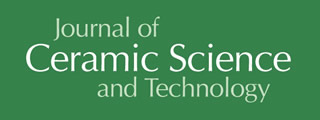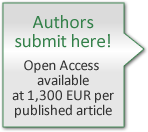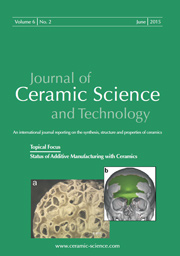Issues
 Journal of Ceramic Science and Technology 2/2016
Journal of Ceramic Science and Technology 2/2016
Vol. 7, No. 2
Topical Issue
Low carbon and carbon-free refractory approaches for advan-ced steel technologies; A challenge for refractory materials and systems.
Guest Editor
Christos Aneziris
Preface
Dear Readers,
Refractories play a key role in all high-temperature applications and cover all the strategic industries such as steel, cement, glass, petrochemicals, energy plants, etc. The understanding of their mechanical, thermal, chemical and functional properties as controlled by their structure at nano-, micro- and macro-levels followed by chemical and physical interactions at interfaces/surfaces is an unlimited tool for continuous development and optimization.
Today the explosion in the price of raw materials as well as environment-related restrictions are challenging refractories companies to continuously develop innovative approaches in material design, material processing and product functionality. Their performance as well as their competitiveness and especially their sustainability are directly interlinked with the availability of industrially oriented well-educated young engineers by understanding refractories as multifunctional advanced ceramic components.
In 2009, the German Research Foundation (DFG) initiated a six-year Priority Program SPP 1418 entitled “Refractory Initiation for Lowering Emissions” for applied basic research in refractories by bridging different material disciplines and understanding refractories as multi-functional ceramic components. The main goals are lower emissions and lower thermal losses in high-temperature applications with improved steel quality in means of clean steel technology thanks to the impact of refractory innovations such as development of a new generation of carbon-bonded refractories with less carbon and development of oxide materials with excellent thermal shock performance.
In 2014 the crude steel production worldwide reached 1665 million tones and according to the World Steel Association by 2050 steel-use is projected to be 1.5 times higher than the present level in order to meet the needs and demands of a growing population. In case of steel production approximately 1 K thermal loss generates costs in the range of 5 cent per ton steel. New material approaches as explored in the priority program such as the addition of nanometer powders for nanoengineered refractories or multilayer designs and multilayer techniques for coarse-grain materials in functional components and lining constructions open the horizon of innovation in this high temperature sector. These investigations are supported by new testing approaches as well as simulation and modeling tools of the microstructure behavior for improved thermal shock performance and low contamination of the metal melt.
The international scientific as well as industrial community follows these activities, underlining the importance of the DFG’s Priority Program by generating international congresses under the banner “Refractories Technology to Sustain the Global Environment” (Kyoto, Japan, 2011), “Refractories Solutions Through Innovations”, (Calcutta, India, 2014) and “More Advanced Refractories, Greener High Temperature Industries”(Xian, China, 2016).
At this point I would like to thank all authors as well as review members, who promote innovation in refractories worldwide under an industrially oriented educational engineering umbrella.
C.G. Aneziris
(Institute of Ceramic, Glass and Construction Materials, TU Bergakademie Freiber)
Microscale-Motivated Continuum Damage Simulations of Brittle Ceramics under Thermomechanical Loading J. Gundlach, D. Henneberg, J. Scheel, A. Ricoeur Vol. 7, No. 2, Pages 145-154 DOI: 10.4416/JCST2016-00012 Keywords: Thermal shock, damage simulations, multiscale models, effective material properties |
Thermal Shock and Thermo-Mechanical Behavior of Carbon-Reduced and Carbon-Free Refractories A. Böhm, S. Dudczig, J. Fruhstorfer, A. Mertke, C.G. Aneziris, J. Malzbender Vol. 7, No. 2, Pages 155-164 DOI: 10.4416/JCST2015-00081 Keywords: Ceramics, refractories, thermal shock, wedge splitting test, electron beam |
Estimation of Damage in Refractory Materials after Progressive Thermal Shocks with Resonant Frequency Damping Analysis N. Traon, T. Tonnesen, R. Telle Vol. 7, No. 2, Pages 165-172 DOI: 10.4416/JCST2015-00080 Keywords: Thermal shock, impulse excitation technique, partially stabilized zirconia, Young's modulus, damping |
Thermal Shock Performance of Refractories for Application in Steel Ingot Casting J. Fruhstorfer, S. Schafföner, J. Werner, T. Wetzig, L. Schöttler, C.G. Aneziris Vol. 7, No. 2, Pages 173-182 DOI: 10.4416/JCST2016-00010 Keywords: Thermal shock resistance, nanoadditives, mullite, alumina-titania-zirconia, fused raw material |
Prediction of Effective Thermal Conductivity of Refractory Materials at High Temperatures based on Synthetic Geometry Generation C. Demuth, J. Hubálková, M.A.A. Mendes, F. Ballani, D. Trimis, S. Ray Vol. 7, No. 2, Pages 183-192 DOI: 10.4416/JCST2016-00006 Keywords: Effective thermal conductivity, refractory materials, random sequential adsorption, finite volume method, thermal contact resistance |
Mechanical Characterisation of Carbon-Bonded Magnesia at Temperatures up to 1400 °C J. Solarek, C.G. Aneziris, H. Biermann Vol. 7, No. 2, Pages 193-202 DOI: 10.4416/JCST2016-00017 Keywords: Refractories, high temperature carbon-bonded magnesia, mechanical properties, creep |
Influence of Interfaces on Crack Propagation through a Layered Refractory Loaded by Thermal Shock J. Hein, O. El Khatib, M. Kuna Vol. 7, No. 2, Pages 203-208 DOI: 10.4416/JCST2016-00004 Keywords: Keywords: Refractories, multilayer ceramics, thermal shock, cohesive zones, interfaces, crack growth |
Carbon-Bonded Alumina Refractories with Reduced Carbon Content due to the Addition of Semi-Conductive Silicon and/or Nanoparticles N. Brachhold, J. Fruhstorfer, A. Mertke, C.G. Aneziris Vol. 7, No. 2, Pages 209-222 DOI: 10.4416/JCST2016-00024 Keywords: Nanoscaled additives, silicon, carbon-bonded alumina, semi-conductive material, reduced graphite |



